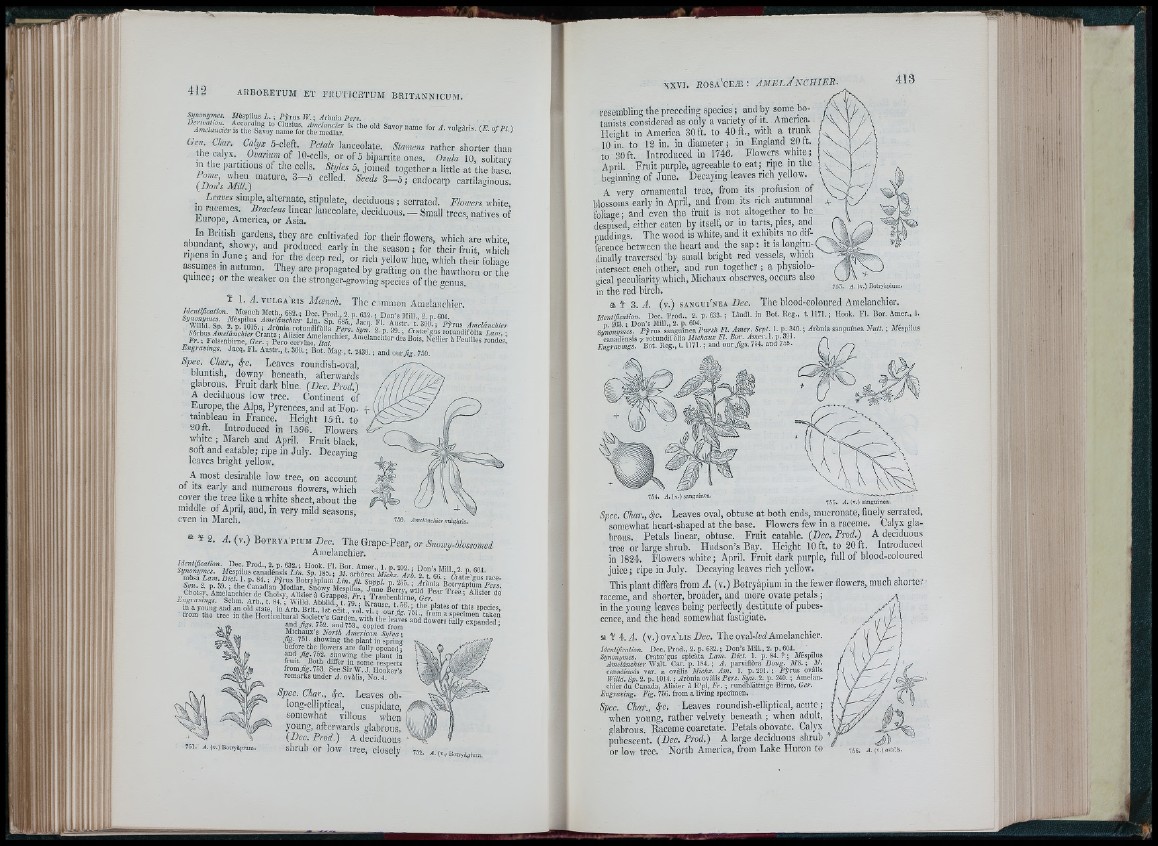
A K B O R E T U M E T F R U T IC E T U M B R IT A N N IC U M .
Sfinonynoes. .J/éspilus L . ; P ÿ ru s JV. ; Avônhx P a s .
Gcn. Char. Calyx à-cMt. Petals lanceolate. Stamens rather shorter than
the calyx. Omnaai of 10-eelk, or of 5 bipartite ones. Ovula 10, solitary
m the partitions ot the cells. Styles 5, joined together a little at tlie base
(D oN m ìU ) ’ cartilaginous.
simple, alternate, stipulate, deciduous; serrated. Wo,cm white,
in laceraes. Bracteas linear lanceolate, deciduous. — Small trees, natives of
Burope, Amenca, or Asia.
Iii Brmsh gardens they are cultivated for their flowers, which are white
T produced early in the season; for their fruit, which
iipens 111 Ju n e ; and for the deep red, or nell yellow hue, which their folia»e
miffire? P™P'*S"®d by grafting on the hawthorn or t£e
quince, or the weaker on the stronger-growing species of the genus.
Ï 1. 4 . v uLG A Ills iifenc/i. The cjnimon Amelânchier.
Jdmtificatmn. M a rc h Meth., 682. ; Dec. Prod., 2. p. 632. -, Don's Siili 2 n BM
Engravings. Jacq. F l. Austr., t. 300. ; Bot. Mag., t. 2430. i and o u rjig . 750.
Spec. Char., 4c. Leaves roundish-oval,
bluntish, downy beneath, afterwards
glabrous. Fruit dark blue. (Dec. Prod.)
A deciduous low tree. Continent of
Europe, the Alps, Pyrenees, and at Ton- f-
tambleau in France. Height 15ft. to
20 ft. Introduced in 1596. Flowers
white ; March and April. Fruit black,
soft and eatable; ripe in July. Decaying
leaves bright yellow.
A most desirable low tree, on account
of its early and numerous flowers, which
cover the tree like a white sheet, about the
middle of April, and, in very mild seasons,
even in March. 750. Amcl,indrier vulgàris.
* Î 2. A. (v.) B o t e v a 'p i u m Dee. The Grape-Pear, or Snoicy-bhssomed
Amelânchier.
■ nom the u . the B o tt l c u .tu ^ . e l ^ s I ™ ^
Michaux’s North American Sylva ■
Jig- 751. showing the plant in spring
before the flowers are fu)!j' opened ;
fig- 762. showing the plant in
fruit. Both dififer in some respects
from ^ g .753. See Sir W .J. Hooker’s
remarks under A. ovàlis, No. 4.
Spec. Char., 4c. Leaves oblong
elliptical, cuspidate,
somewhat villous when
young, afterwards glabrous.
(Dee. Prod.) A deciduous
shrub or low 751. .4. (v.) Botrjàiiiui tree, closely » 2. a.
XXVI. j j o s a ' c e a ! : a m e l J n c i i i f .b .
resembling the preceding species ; and by some botanists
considered as only a variety of it. Amenca.
Height in America 30 ft. to 40 ft., with a trunk
10 in. to 12 in. in diameter; in England 20 ft.
to so ft. Introduced in 1746. Flowers white;
April. Fruit purple, agreeable to e a t; ripe in the
beginning of June. Decaying leaves rich yellow.
A very ornamental tree, from its profusion of
blossoms early in April, and from its rich autumnal
foliage; and even the fruit is not altogether to be
despised, either eaten by itself, or in tarts, pies, and
puddings. The wood is white, and it exhibits no difference
between the heart and the sap : it is longitudinally
traversed by small bright red vessels, which
intersect each other, and run together ; a physiological
peculiarity which, Michaux observes, occurs also
in the red birch.
at S S. A. (v.) sanodi' nea Dec.
lientmcation. Dec. P rod., 2. p. 633. ; Lmill. in Bot. Keg., t. 1171.
p. 203. ! Don’s Mill., 2, p. 604.
Í55. A . (v.) Botryà[)ium.
Tiie blood-coloured Amelânchier.
Hook. F l. Bor. Amer., 1.
P- 5 s a n g u ín e a N u it. ; Méspilus
canadénsis y ro tu n d ifò lia Michaux Fl. Bor. Am e r .l. p. 39J. ^
Engravings. B o t. R e g ., t. 1171. ; a n d o u r 754. a n d ? - - -
754. j4 . ( v.) sanguinea.
755. A . (V.) sanguínea,
Spec. Char., Leaves oval, obtuse at both ends, mucronate, finely serrated,
somewhat heart-shaped at the base. Flowers few in a raceme. Calyx glabrous.
Petals linear, obtuse. Fruit eatable. (Dec. Prod.) A deciduous
tree or large shrub. Hudson’s Bay. Height 10 ft. to 20 ft. Introduced
in 1824. Flowers white; April. Fruit dark purple, full of blood-coloured
juice; ripe in July. Decaying leaves rich j-ellow.
This plant differs from A. (v.) Botryàpium in the fewer flowers, much shorter
raceme, and shorter, broader, and more ovate petals ;
in the young leaves being perfectly^ destitute of pubescence,
and the head somewhat fastigiate.
Sfe’f 4. ff. (v.) o v a ' l i s Dec. The oval-ZycZ Amelânchier.
Identification. Dec. Prod., 2. p. 632. ; Don’s Mi]!., 2. p . 604.
Synonymes. Cratæ'gus spicàta L am. Bict. 1. p. 84. ? ; Mespilus
AinelánchierVi&Vc. Car. p. 184. ; A. parviflòra B o v e . M S .\ M.
canadénsis var. « ovàlis Michx. Am. 1. p. 291. ; P ÿ ru s ovalis
Willd. Sp. 2. p. 1014. ; jirònia ovàlis Pej'S. Syn. 2. p. 240. ; Amelan-
chier du Canada, Alisier à E'pi, Fr. ; rundblattrige Birne, Ger.
Engraving. Fig. 756. from a living specimen.
Spec. Char., 4c. Leaves roundish-elliptical, acute ;
when young, rather velvety beneath ; when adult,
glabrous. Raceme coarctate. Petals obovate. Calyx
pubescent. {Bee. Prod.) A large deciduous shrub
or low tree. North A.merica, from Lake Huron to ’ a. <v.) ovà-.is.
i I!!í a í J